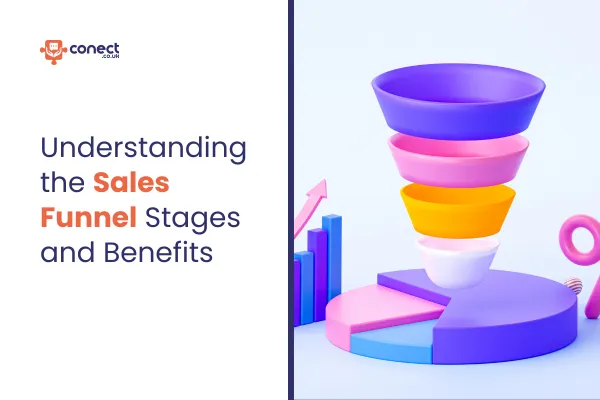
What Is a Sales Funnel? Learn Its Importance and Stages
Understanding the Sales Funnel: Stages and Benefits
What Is a Sales Funnel?
A sales funnel is a strategic model that helps businesses visualize and manage the process of turning prospects into paying customers. This model breaks the customer journey into distinct stages, with each stage serving to filter and refine the leads until they make a purchase. The sales funnel is an essential tool for businesses, as it helps optimize marketing efforts, tailor customer interactions, and ultimately increase conversions.
Understanding the sales funnel can provide clarity on how to guide potential customers through each stage of their buying journey. Let’s explore the stages of a typical sales funnel and understand why it's an important framework for achieving business success.
The Stages of a Sales Funnel
A typical sales funnel is divided into several stages. Let’s go through each one to understand how they contribute to the overall process.
1. Awareness Stage
The awareness stage is the top of the funnel, where potential customers first become aware of your product or service. At this point, they might not know about your brand or what it offers, but they’re starting to recognize their problem or need. This is a crucial stage for your business to capture the attention of as many people as possible. Many of them will likely be cold leads with little to no information about your product.
Key activities in this stage:
Blog posts
Social media content
Paid advertisements
SEO optimization
Attracting attention is the goal here. You need to position your product or service in front of as many people as possible, engaging them with content that resonates with their needs or interests. Content marketing, SEO, and paid advertising are effective strategies for driving awareness.
2. Interest Stage
Once prospects are aware of your product, the next step is to spark their interest. In this stage, potential customers are considering solutions to their needs or problems. They may engage with your content, subscribe to your newsletter, or follow you on social media. The goal here is to nurture their interest by providing more detailed information about how your product can solve their problems.
Key activities in this stage:
Offering free resources (eBooks, whitepapers)
Email marketing campaigns
Webinars
Demonstrating product benefits
You need to start building a relationship with your leads at this stage. Provide them with value-driven content that answers their questions, solves problems, or addresses pain points. This builds trust and positions your product as a potential solution.
3. Consideration Stage
At this point, leads are evaluating different options to solve their problem. They’re considering your product alongside others. This is a critical stage where you must demonstrate why your solution is the best choice. You want to make sure your potential customers feel confident that your product or service is the best option for them.
Key activities in this stage:
Case studies
Customer testimonials
Product comparisons
Free trials or demos
This is where you show the prospect that your product is the solution they are looking for. Highlight your unique selling points, showcase success stories, and provide data to back up your claims. The goal is to convince them that your product will deliver the results they need.
4. Decision Stage
Now, the lead is ready to make a decision. They are evaluating the final aspects of your product, such as pricing, features, and customer service. They might be choosing between several products, and you need to address their last-minute concerns to help them feel confident in their purchase decision.
Key activities in this stage:
Discounts or special offers
Sales presentations
Clear calls to action (CTAs)
Personal consultations
At this stage, your goal is to remove any remaining obstacles that may prevent the customer from making a purchase. Offer limited-time deals, incentives, or customized solutions to sweeten the deal and push them to make a final decision. A strong call to action (CTA) is essential at this point to encourage the customer to take the next step.
5. Action Stage
The action stage is when the prospect converts into a customer. They make a purchase or take the desired action (e.g., signing up for a service). This is the ultimate goal of the sales funnel – to turn interest into tangible revenue.
Key activities in this stage:
Easy checkout process
Providing payment options
Post-purchase follow-ups
After the sale, follow up with the customer to ensure satisfaction and keep them engaged for future purchases. A seamless checkout experience is essential to prevent cart abandonment. Moreover, after-sales support and engagement help in retaining customers and turning them into repeat buyers.
Why Sales Funnels Are Important
A well-structured sales funnel allows businesses to understand where their customers are in the decision-making process. It provides insights into which stage most of your leads are in, helping you target them more effectively. By mapping out the customer journey, you can tailor your marketing efforts to guide them through each stage, from awareness to action. This results in a higher conversion rate and better ROI.
Understanding your funnel also helps optimize your marketing efforts. For instance, if you notice that a lot of prospects are getting stuck in the consideration stage, it might be an indication that you need to improve your case studies or provide more educational content. By analyzing your sales funnel regularly, you can identify areas for improvement and adjust your strategies accordingly.
Tips for Improving Your Sales Funnel
Now that you know what a sales funnel is, here are some tips for improving your funnel and increasing conversions:
Segment Your Audience: Not all leads are at the same stage. Segmenting your audience based on behavior helps in providing more personalized marketing efforts. For example, a lead in the awareness stage needs different content than one in the decision stage.
Optimize Content for Each Stage: Create content tailored to the needs and interests of your audience at each stage. For example, blog posts and social media posts work well for the awareness stage, while case studies and product demos are better for the consideration stage.
Use Analytics: Regularly analyze funnel data to understand where you’re losing customers and take steps to improve those areas. Are customers abandoning your website at the consideration stage? Is your conversion rate lower than expected at the decision stage? Use analytics to make data-driven decisions that optimize your funnel.
Automate Follow-ups: Use automated email sequences to nurture leads through the funnel stages without manual effort. Automation ensures that no lead is forgotten and that your follow-ups are timely and relevant.
Common Sales Funnel Mistakes to Avoid
While creating a sales funnel, avoid the following pitfalls:
Ignoring Lead Nurturing: You can’t expect leads to convert without nurturing them first. Make sure you provide valuable content throughout the funnel. Don’t rush the process; building trust takes time.
Overcomplicating the Process: A simple, streamlined sales funnel is more effective than one that’s too complicated. Don’t overwhelm potential customers with too many choices or steps. Make the process clear and easy to follow.
Not Tracking Your Funnel: You can’t improve what you don’t measure. Make sure to track your funnel metrics (conversion rates, bounce rates, etc.) and adjust your strategies based on the data. Regular tracking helps you stay on top of your funnel’s performance.
FAQs
1. What is the first step in converting leads into customers?
The first step is to attract potential customers' attention through various marketing channels, such as social media, blog posts, and paid ads.
2. How can I guide my leads through the different stages?
Provide targeted content and solutions at each stage, offering value and building trust until they are ready to make a purchase.
3. What should I focus on during the decision-making stage?
During this stage, highlight your product's unique features and offer promotions or clear calls to action to encourage the final purchase.
4. Why is segmenting my audience important?
Segmenting your audience helps deliver personalized content and marketing efforts, which in turn increase engagement and improve conversion rates.
5. How can I track the success of my sales process?
Monitor metrics such as conversion rates, bounce rates, and customer behavior to identify which stages need improvement and optimize your approach.
Conclusion
Understanding what a sales funnel is and how it works can dramatically impact your ability to convert leads into customers. The key is to guide prospects through the stages from awareness to action, using the right strategies at each point. A well-executed sales funnel can increase your conversions, drive sales, and ultimately help grow your business.
By following the best practices outlined above, you can optimize your funnel and improve your overall sales process. Remember, the success of your funnel depends on how well you nurture and guide your leads to the final action. Investing in a solid sales funnel strategy can lead to better customer retention, more sales, and a stronger bottom line.

The All-In-One Solution to grow your business. Capture Free Leads And Conversationally Covert Them Into Customers!
Contact information
Address : Layton Lane, Rawdon, Leeds, LS19 6RG
Phone : +44 7859 775480
Email : [email protected]

